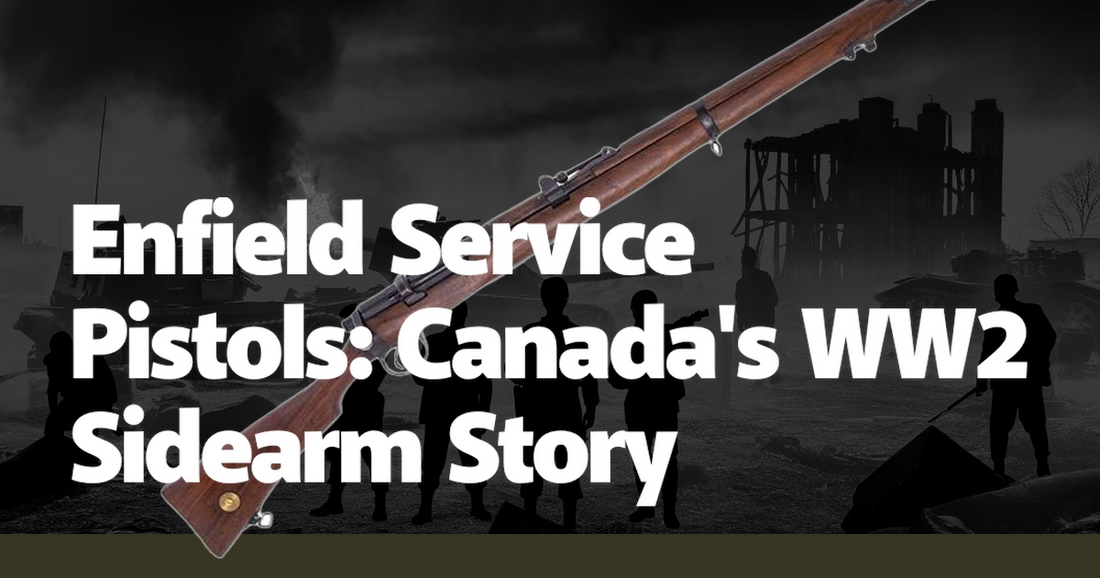The Enfield service pistols, particularly the Enfield No. 2 Mk I*, played a pivotal role in the hands of Canadian forces during World War II. These revolvers, manufactured by the Royal Small Arms Factory in Enfield, England, were the standard sidearms issued to British and Commonwealth troops. For Canadian soldiers, the Enfield was more than just a weapon; it was a symbol of their resilience and adaptability in the face of the global conflict. The revolver's robust design and reliability in harsh conditions made it a trusted companion in the varied and often brutal theaters of war. The Enfield No. 2 Mk I* was chambered in .38/200 caliber, a modification of the .38 S&W cartridge, which provided a balance between stopping power and manageable recoil, essential for the close-quarters combat scenarios often encountered by Canadian troops.
The adoption of the Enfield revolvers by Canadian forces can be traced back to the interwar period, where the need for a reliable sidearm became increasingly apparent. The Enfield No. 2 Mk I* was a double-action revolver, but the Mk I* variant was modified to double-action only, eliminating the hammer spur to prevent snagging on clothing and equipment. This design choice was particularly beneficial in the unpredictable and chaotic environments of World War II, where quick-draw capability and ease of use were paramount. Canadian soldiers appreciated the Enfield for its simplicity and effectiveness, traits that were sorely needed in the diverse battlefields ranging from the deserts of North Africa to the hedgerows of Normandy.
One notable example of the Enfield's significance to Canadian forces is the story of Major David Currie, a Canadian officer who was awarded the Victoria Cross for his actions during the Battle of Falaise Pocket in August 1944. Currie led his troops in a critical engagement that helped seal the encirclement of German forces. Throughout the intense fighting, Currie was often seen with his Enfield revolver at his side, a testament to the weapon's role in the hands of Canadian leaders. The revolver's reliability allowed Currie to focus on commanding his men and making split-second decisions that would turn the tide of battle.
The Enfield revolvers were not without their limitations, however. The .38/200 cartridge, while effective at short ranges, lacked the stopping power of larger calibers. Some Canadian soldiers expressed a preference for the Colt M1911 or the Browning Hi-Power, both chambered in the more powerful .45 ACP and 9mm Parabellum, respectively. Despite these preferences, the Enfield remained the standard issue due to its availability and the logistical challenges of supplying different ammunition types. The revolver's rugged construction and ease of maintenance in the field often outweighed the desire for a more powerful sidearm.
In the harsh winters of the Italian Campaign, the Enfield's performance in cold weather conditions was put to the test. Canadian soldiers found that the revolver continued to function reliably despite freezing temperatures and the accumulation of dirt and grime. This reliability was crucial during the grueling battles for control of the Liri Valley and the Gothic Line, where Canadian forces faced determined German resistance. The Enfield's ability to operate in such adverse conditions reinforced its status as a dependable sidearm for Canadian troops.
The legacy of the Enfield service pistols extends beyond their use in World War II. After the war, many of these revolvers were retained by Canadian forces and saw continued service in various capacities. They were used for training and even saw action in the Korean War, where Canadian soldiers once again relied on their trusted sidearms in the brutal and unforgiving terrain of the Korean Peninsula. The Enfield's enduring presence in the Canadian military arsenal is a testament to its effectiveness and the high regard in which it was held by those who carried it.
Personal accounts from Canadian veterans further highlight the Enfield's impact. Stories of soldiers who carried their Enfield revolvers through some of the most intense battles of the war provide a human perspective on this iconic weapon. These anecdotes reveal the emotional connection many soldiers had with their sidearms, viewing them as both a tool of survival and a symbol of their service and sacrifice. The Enfield revolvers, with their distinctive design and storied history, remain a poignant reminder of the courage and determination of Canadian forces during World War II.
In conclusion, the Enfield service pistols, particularly the No. 2 Mk I*, hold a significant place in Canada's World War II history. Their reliability, simplicity, and effectiveness made them an indispensable tool for Canadian soldiers across various theaters of war. The stories of bravery and resilience associated with these revolvers underscore their importance not just as weapons, but as symbols of the indomitable spirit of the Canadian forces. The Enfield's legacy continues to be remembered and honored, reflecting the profound impact it had on those who wielded it in the fight for freedom.

